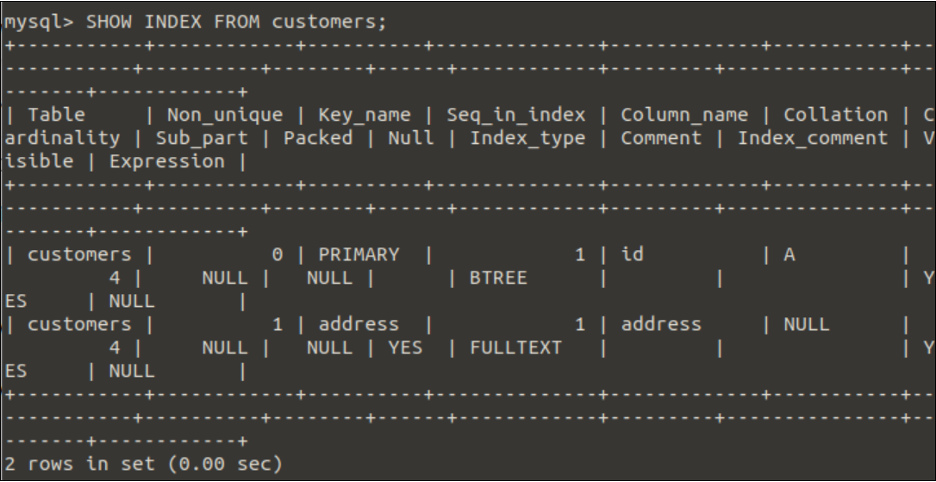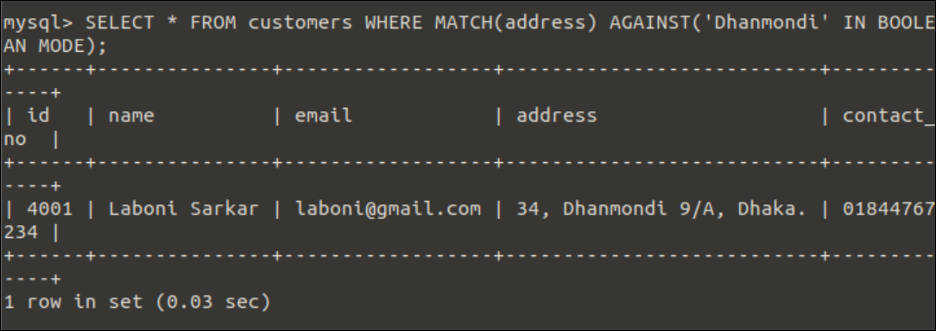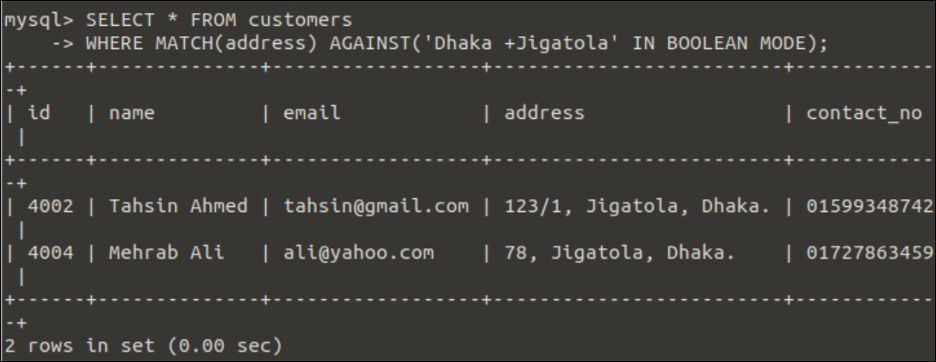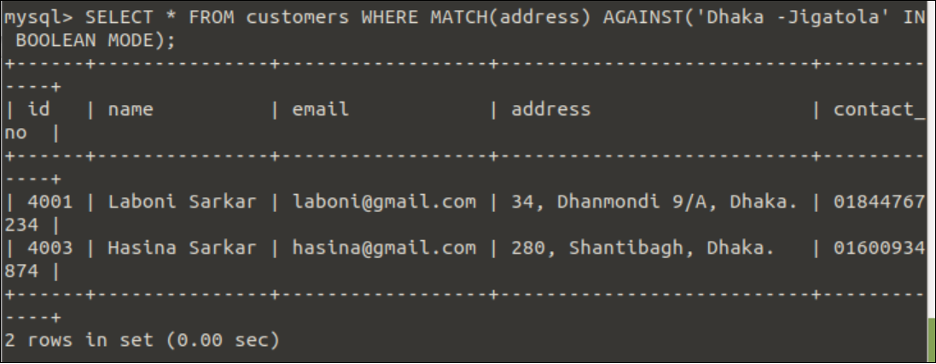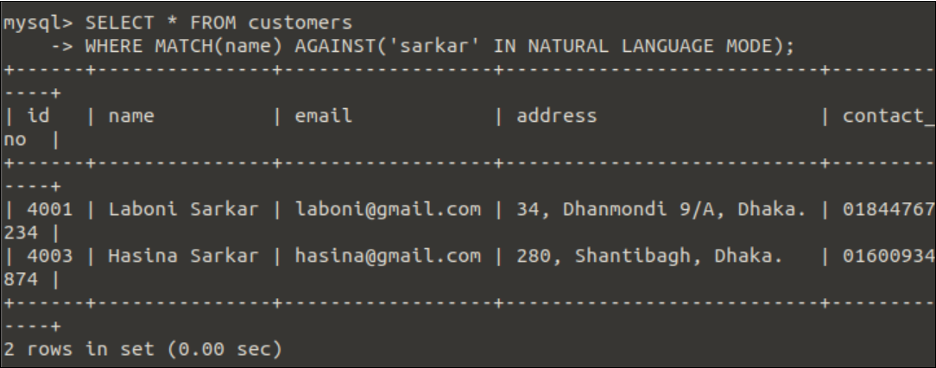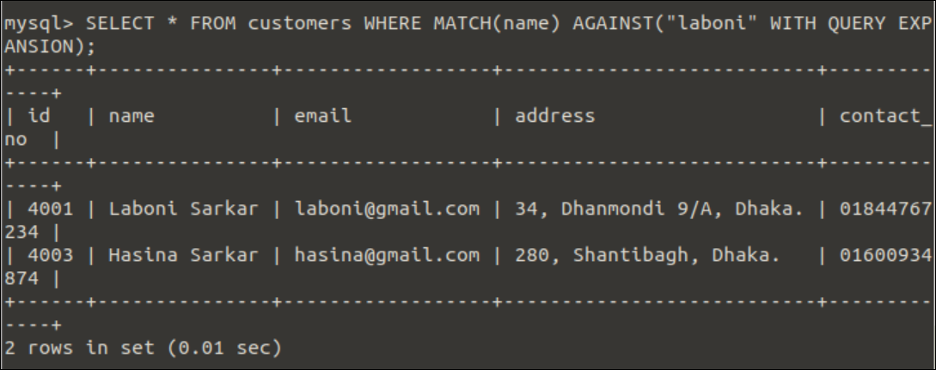Features of FULLTEXT Index
- It can be applied to the CHAR, VARCHAR, and TEXT fields of the table.
- It supports InnoDB and MyISAM storage engines.
- It is used with MATCH() and AGAINST() clauses only
Types of FULLTEXT Search Modes
Three types of searching can be accomplished using the FULLTEXT index, which is explained below:
1. Boolean Mode
This type of searching is used for the queries that contain Boolean operators, such as less than (‘<‘) and more than (‘>’) operator, plus sign (‘+’), minus sign (‘-‘), double quotes (“”), wildcard operator (‘*), etc.
2. Natural Language Mode
The default search type interprets the search string as a literal phase.
3. Query Expansion Mode
The search is done two times in this searching type. The second search is applied to the result of the first search to find out the most relevant searching output.
Prerequisites
Create a table with data in a MySQL database to check the use of FULLTEXT search in MySQL. Open the terminal and connect to the MySQL server by executing the following command:
Run the following command to create a database named test_db:
Run the following command to select the database:
Run the following query to create a table named customers with five fields:
id INT NOT NULL PRIMARY KEY,
name VARCHAR(30) NOT NULL,
email VARCHAR(50),
address TEXT,
contact_no VARCHAR(15));
Run the following INSERT query to insert four records into the customers table.
('4001', 'Laboni Sarkar', '[email protected]', '34, Dhanmondi 9/A, Dhaka.', '01844767234'),
('4002', 'Tahsin Ahmed', '[email protected]', '123/1, Jigatola, Dhaka.', '01599348742'),
('4003', 'Hasina Sarkar', '[email protected]', '280, Shantibagh, Dhaka.', '01600934874'),
('4004', 'Mehrab Ali', '[email protected]', '78, Jigatola, Dhaka.', '01727863459');
Run the following command to add the FULLTEXT index for the address field of the customers table:
Run the following command to check the list of the defined indexes of the customers table:
Output
The following output shows that two indexes exist for the customers table. One is the BTREE index that has been defined by default for the primary field, and another is the FULLTEXT index that has been defined later for the address field:
Uses of FULLTEXT Searching
The search in the table using different modes of the FULLTEXT index has been shown in this tutorial.
FULLTEXT Search in Boolean Mode
The following SELECT query will search the word ‘Dhanmondi’ in the address field of the customers table in Boolean mode. The customers table contains just one record matching this criterion:
Output
The following output will appear after executing the previous query:
Run the following SELECT query to search both words, ‘Dhaka’ and ‘Jigatola’ in the address field of the customers table by using the FULLTEXT index in Boolean mode. There are two rows in the customers table that contain both words, ‘Dhaka’ and ‘Jigatola’:
WHERE MATCH(address) AGAINST('Dhaka +Jigatola' IN BOOLEAN MODE);
Output
The following output will appear after executing the previous query. The output shows that the address field contains ‘Dhaka’ and ‘Jigatola’:
Run the following SELECT query to search those rows of the customers table that contain the word ‘Dhaka’ but does not contain the word ‘Jigatola’ in the address field of the customers table using FULLTEXT index in Boolean mode. Two rows exist in the customers table that match the criteria:
Output
The following output will appear after executing the previous query. The output shows the address field contains ‘Dhaka’ but not ‘Jigatola’:
FULLTEXT Search in Natural Language Mode
Run the following command to add the FULLTEXT index for the name field of the customers table:
The following SELECT query will search the word ‘sankar’ in the name field of the customers table in Natural Language mode. The customers table contains two records matching this criterion:
WHERE MATCH(name) AGAINST('sarkar' IN NATURAL LANGUAGE MODE);
Output
The following output will appear after executing the previous query. The rows that contain the ‘sarkar’ value in the name field have been shown in the output:
FULLTEXT Search in Query Expansion Mode
The following SELECT query will search the word ‘laboni’ in the name field of the customers table in Query Expansion mode. The customers table contains two records matching with this criterion:
WHERE MATCH(name) AGAINST("laboni" WITH QUERY EXPANSION);
Output
The following output will appear after executing the previous query. In the output, the name field of the first row contains the word ‘Laboni’ with another word, ‘Sarkar’, and the name field of the second row contains the matching word, ‘Sarkar’.
Drop FULLTEXT Index
Run the following command to drop the FULLTEXT index of the name field:
Run the following command to check the current index list of the customers table after removing the FULLTEXT index from the name field:
Output
The following output will appear after executing the previous query. The output shows that the customers table contains one BTREE index for the id field and one FULLTEXT for the address field:
Conclusion
The different ways of searching content in a table using the FULLTEXT index have been shown in this tutorial to help the new MySQL users learn the uses of FULLTEXT searching in MySQL. In addition, the full features for the FULLTEXT index were discussed. We hope you found this article helpful. Check out other Linux Hint articles for more tips and tutorials.

